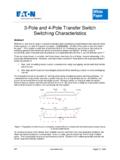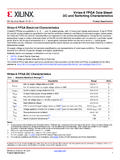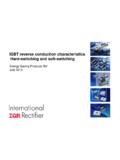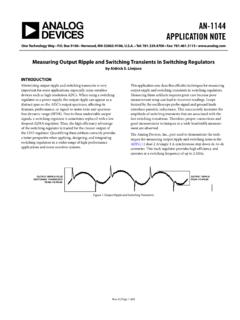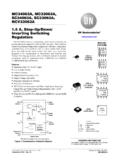Transcription of Spartan-6 FPGA Data Sheet: DC and Switching ...
1 DS162 ( ) January 30, Specification1 2009 2015 xilinx , Inc. xilinx , the xilinx logo, Virtex, Zynq, Artix, Kintex, Spartan, ISE, and other designated brands included herein are trademarks of xilinx in the United States and other countries. All other trademarks are the property of their respective FPGA Electrical CharacteristicsSpartan -6 LX and LXT FPGAs are available in various speed grades, with -3 having the highest performance. The DC and AC electrical parameters of the Automotive XA Spartan-6 FPGAs and Defense-grade Spartan-6Q FPGAs devices are equivalent to the commercial specifications except where noted. The timing characteristics of the commercial (XC) -2 speed grade industrial device are the same as for a -2 speed grade commercial device. The -2Q and -3Q speed grades are exclusively for the expanded (Q) temperature range. The timing characteristics are equivalent to those shown for the -2 and -3 speed grades for the Automotive and Defense-grade FPGA DC and AC characteristics are specified for commercial (C), industrial (I), and expanded (Q) temperature ranges.
2 Only selected speed grades and/or devices might be available in the industrial or expanded temperature ranges for Automotive and Defense-grade devices. References to device names refer to all available variations of that part number (for example, LX75 could denote XC6 SLX75, XA6 SLX75, or XQ6 SLX75). The Spartan-6 FPGA -3N speed grade designates devices that do not support MCB supply voltage and junction temperature specifications are representative of worst-case conditions. The parameters included are common to popular designs and typical applications. Available device and package combinations can be found at: DS160: Spartan-6 Family Overview DS170: Automotive XA Spartan-6 Family Overview DS172: Defense-Grade Spartan-6Q Family OverviewThis Spartan-6 FPGA data sheet , part of an overall set of documentation on the Spartan-6 family of FPGAs, is available on the xilinx website at FPGA DC characteristics 89 Spartan-6 FPGA data Sheet: DC and Switching CharacteristicsDS162 ( ) January 30, 2015 Product SpecificationTa b l e 1 :Absolute Maximum Ratings(1)SymbolDescriptionUnitsVCCINTI nternal supply voltage relative to GND to supply voltage relative to GND to drivers supply voltage relative to GND to memory battery backup supply (LX75, LX75T, LX100, LX100T, LX150, and LX150T only) to voltage supply for eFUSE programming (LX75, LX75T, LX100, LX100T, LX150, and LX150T only)(2) to reference voltage to FPGA data sheet .
3 DC and Switching CharacteristicsDS162 ( ) January 30, Specification2 VIN and VTS(3)I/O input voltage or voltage applied to 3-state output, relative to GND(4)All user and dedicated I/OsCommercialDC to overshoot duration to overshoot duration(5) to to overshoot duration to overshoot duration(5) to (Q)DC to overshoot duration to overshoot duration(5) to to maximum of 100 user I/OsCommercial20% overshoot duration to overshoot duration(5) to overshoot duration to overshoot duration to overshoot duration to overshoot duration(5) to (Q)20% overshoot duration to overshoot duration to overshoot duration(5) to temperature (ambient) 65 to 150 CTSOLM aximum soldering temperature(6)(TQG144, CPG196, CSG225, CSG324, CSG484, and FTG256)+260 CMaximum soldering temperature(6) (Pb-free packages: FGG484, FGG676, and FGG900)+250 CMaximum soldering temperature(6) (Pb packages: CS484, FT256, FG484, FG676, and FG900)+220 CTjMaximum junction temperature(6)+125 CNotes: beyond those listed under Absolute Maximum Ratings might cause permanent damage to the device.
4 These are stress ratings only, and functional operation of the device at these or any other conditions beyond those listed under Operating Conditions is not implied. Exposure to Absolute Maximum Ratings conditions for extended periods of time might affect device programming eFUSE, VFS VCCAUX. Requires up to 40 mA current. For read mode, VFS can be between GND and absolute maximum limit applied to DC and AC signals. Overshoot duration is the percentage of a data period that the I/O is stressed beyond I/O operation, refer to UG381: Spartan-6 FPGA SelectIO Resources User percent overshoot duration to meet is the maximum soldering temperature for component bodies. For soldering guidelines and thermal considerations, see UG385: Spartan-6 FPGA Packaging and Pinout b l e 1 :Absolute Maximum Ratings(1) (Cont d)SymbolDescriptionUnitsSpartan-6 FPGA data sheet : DC and Switching CharacteristicsDS162 ( ) January 30, Specification3 Ta b l e 2 :Recommended Operating Conditions(1)SymbolDescriptionMinTypMaxU nitsVCCINTI nternal supply voltage relative to GND-3, -3N, -2 Standard performance(2) , -2 Extended performance(2) performance(2) (3)(4)Auxiliary supply voltage relative to GNDVCCAUX= (5) (6)(7)(8)Output supply voltage relative to voltage relative to GNDAll I/O standards (except PCI)Commercial temperature (C) temperature (I) (Q) temperature I/O standard(9) VCCO+ (10)Maximum current through pin using PCI I/O standard when forward biasing the clamp diode.
5 (9)Commercial (C) and Industrial temperature (I) 10mAExpanded (Q) temperature 7mAMaximum current through pin when forward biasing the ground clamp diode. 10mAVBATT(11)Battery voltage relative to GND, Tj=0 C to +85 C(LX75, LX75T, LX100, LX100T, LX150, and LX150T only) temperature operating rangeCommercial (C) range0 85 CIndustrial temperature (I) range 40 100 CExpanded (Q) temperature range 40 125 CNotes: voltages are relative to Interface Performances for Memory Interfaces in Ta b l e 2 5. The extended performance range is specified for designs not using the standard VCCINT voltage range. The standard VCCINT voltage range is used for: Designs that do not use an MCB LX4 devices Devices in the TQG144 or CPG196 packages Devices with the -3N speed maximum voltage droop for VCCAUX is 10 configuration, if VCCO_2 is , then VCCAUX must be -1L devices require VCCAUX= when using the LVDS_25, LVDS_33, BLVDS_25, LVPECL_25, RSDS_25, RSDS_33, PPDS_25, and PPDS_33 I/O standards on inputs.
6 LVPECL_33 is not supported in the -1L data is retained even if VCCO drops to VCCO of , , , , and PCI systems, the transmitter and receiver should have common supplies for with a -1L speed grade do not support xilinx PCI Do not exceed a total of 100 mA per VBATT is required to maintain the battery backed RAM (BBR) AES key when VCCAUX is not applied. Once VCCAUX is applied, VBATT can be unconnected. When BBR is not used, xilinx recommends connecting to VCCAUX or GND. However, VBATT can be FPGA data sheet : DC and Switching CharacteristicsDS162 ( ) January 30, Specification4Ta b l e 3 : eFUSE Programming Conditions(1)SymbolDescriptionMinTypMax UnitsVFS(2)External voltage supply current 40mAVCCAUXA uxiliary supply voltage relative to (3)External resistor from RFUSE pin to GND112911401151 VCCINTI nternal supply voltage relative to range15 85 CNotes: specifications apply during programming of the eFUSE AES key. Programming is only supported through AES key is only supported in the following devices: LX75, LX75T, LX100, LX100T, LX150, and programming eFUSE, VFS must be less than or equal to VCCAUX.
7 When not programming or when eFUSE is not used, xilinx recommends connecting VFS to GND. However, VFS can be between GND and RFUSE resistor is required when programming the eFUSE AES key. When not programming or when eFUSE is not used, xilinx recommends connecting the RFUSE pin to VCCAUX or GND. However, RFUSE can be FPGA data sheet : DC and Switching CharacteristicsDS162 ( ) January 30, Specification5Ta b l e 4 :DC characteristics Over Recommended Operating ConditionsSymbolDescriptionMinTypMaxUnit sVDRINTData retention VCCINT voltage (below which configuration data might be lost) VVDRAUXData retention VCCAUX voltage (below which configuration data might be lost) VIREFVREF leakage current per pin for commercial (C) and industrial (I) devices 10 10 AVREF leakage current per pin for expanded (Q) devices 15 15 AILI nput or output leakage current per pin (sample-tested) for commercial (C) and industrial (I) devices 10 10 AInput or output leakage current per pin (sample-tested) for expanded (Q) devices 15 15 AIHSL eakage current on pins during hot socketing with FPGA unpoweredAll pins except PROGRAM_B, DONE, and JTAG pins when HSWAPEN = 1 20 20 APROGRAM_B, DONE, and JTAG pins, or other pins when HSWAPEN = 0 IHS(HSWAPEN = 1) + IRPU ACIN(1)Die input capacitance at the pad 10pFIRPUPad pull-up (when selected)
8 @ VIN=0V, VCCO= or VCCAUX= 500 APad pull-up (when selected) @ VIN=0V, VCCO= or VCCAUX= 350 APad pull-up (when selected) @ VIN=0V, VCCO= 200 APad pull-up (when selected) @ VIN=0V, VCCO= 150 APad pull-up (when selected) @ VIN=0V, VCCO= 100 AIRPDPad pull-down (when selected) @ VIN=VCCO, VCCAUX= 550 APad pull-down (when selected) @ VIN=VCCO, VCCAUX= 400 AIBATT(2)Battery supply current 150nARDT(3)Resistance of optional input differential termination circuit, VCCAUX= 100 RIN_TERM(5)Thevenin equivalent resistance of programmable input termination to VCCO (UNTUNED_SPLIT_25) for commercial (C) and industrial (I) devices232555 Thevenin equivalent resistance of programmable input termination to VCCO (UNTUNED_SPLIT_25) for expanded (Q) devices202555 Thevenin equivalent resistance of programmable input termination to VCCO (UNTUNED_SPLIT_50) for commercial (C) and industrial (I) devices395072 Thevenin equivalent resistance of programmable input termination to VCCO (UNTUNED_SPLIT_50) for expanded (Q) devices325074 Thevenin equivalent resistance of programmable input termination to VCCO (UNTUNED_SPLIT_75) for commercial (C) and industrial (I) devices5675109 Thevenin equivalent resistance of programmable input termination to VCCO (UNTUNED_SPLIT_75) for expanded (Q) devices4775115 ROUT_TERMT hevenin equivalent resistance of programmable output termination (UNTUNED_25)112552 Thevenin equivalent resistance of programmable output termination (UNTUNED_50)215096 Thevenin equivalent resistance of programmable output termination (UNTUNED_75)2975145 Notes: CIN measurement represents the die capacitance at the pad, not including the value specified for worst case process at 25 C.
9 LX75, LX75T, LX100, LX100T, LX150, and LX150T to IBIS models for RDT variation and for values at VCCAUX= IBIS values for RDT are valid for all temperature is not required for data retention. The minimum VCCO2for power-on reset and configuration is resistance to a VCCO/2 FPGA data sheet : DC and Switching CharacteristicsDS162 ( ) January 30, Specification6 Quiescent CurrentTypical values for quiescent supply current are specified at nominal voltage, 25 C junction temperatures (Tj). Quiescent supply current is specified by speed grade for Spartan-6 devices. xilinx recommends analyzing static power consumption using the xilinx Power Estimator (XPE) tool (download at ) for conditions other than those specified in Ta b l e b l e 5 :Typical Quiescent Supply CurrentSymbolDescriptionDeviceSpeed GradeUnits-3-3N-2-1 LICCINTQQ uiescent VCCINT supply VCCO supply FPGA data sheet : DC and Switching CharacteristicsDS162 ( ) January 30, Specification7 ICCAUXQQ uiescent VCCAUX supply : values are specified at nominal voltage, 25 C junction temperatures (Tj).
10 Industrial (I) grade devices have the same typical values as commercial (C) grade devices at 25 C, but higher values at 100 C. Use the XPE tool to calculate 100 C values. Nominal VCCINT is ; use the XPE tool to calculate values for the nominal VCCINT of the extended performance values are for blank configured devices with no output current loads, no active input pull-up resistors, all I/O pins are 3-state and differential signaling is used, more accurate quiescent current estimates can be obtained by using the xilinx Power Estimator (XPE) or xilinx Power Analyzer (XPA) b l e 6 :Power Supply Ramp TimeSymbolDescriptionSpeed GradeRamp TimeUnitsVCCINTRI nternal supply voltage ramp time-3, -3N, to to (1)Output drivers bank 2 supply voltage ramp to supply voltage ramp to : minimum VCCO2for power-on reset and configuration is FPGAs require a certain amount of supply current during power-on to insure proper device initialization. The actual current consumed depends on the power-on ramp rate of the power supply.










